Large Framed Service Record of Henry Rishell, 11th Reg., PA Vols.
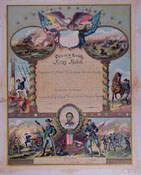
Click to Enlarge |
Extremely Beautiful Color Lithographic Service record for Henry Rishell in the Civil War. Served in 11 the Pennsylvania. His specific information was hand-added in beautiful calligraphy, outlining all his location engagements. Chromolithographic vignettes of Infantry, Cavalry, Navy soldiers as well as actual battles! A big 28"h x 20"w. Small stains, holes. Laid to museum board. This image was a very popular wall record amongst Union veterans. As proud veterans had these made for their homes & offices, it is housed in an impressive oak & gesso molded frame.
Patriotic CDV
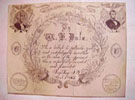
Click to Enlarge |
This is an interesting photographic miniature copy of a formal certificate presented to "W.F. Dale"…as a "tribute to patriotic zeal…" It is only 2 1/2" by 2" on a cardboard CDV mount card. Created by a photograher in "Sing,Sing, N.Y" which is the site of a Federal prison near Tarrytown along the Hudson River. It is inscribed "Julia Jones from W.F.D. Aug. 1867"
1861 Infabtry Tactics book of 11th Maryland COLONEL

Click to Enlarge |
This is a very nice original 1861 Infantry Tactics military manual which belonged to William Taylor Landstreet, the Colonel of the 11th Maryland Regiment. He signed it in front leaf in pencil with an 1862 date. The 11th Defended Washington early in the war. The book has gold-embossed title and eagle on spine. Solid cover & spine. 450 interesting pages on formations, tactics and techniques. Several fold out pages and other steel engravings of soldiers. A very fine book used by a Colonel defending Washington.Doesn't get better than this one!
Man's Ring: Berkeley Plantation near City Point, Va

Click to Enlarge |
A nice brass ring which had been gold plated that has scroll-patterns casted into it. A large stone is now missing. Fits a man's pinky finger. Berkeley Plantation was both a Confederate and Union camp site.
Ivory Handled Boot Pull

Click to Enlarge |
This is a lovely item. An ivory handled boot pull of fine quality, with a heavy, solid construction. The shank/hook portion appear to be plated in silver, but could be an early nickle-alloy. In any case, this item would be used by a cavalry officer to help pull up his boots by the top strap.
CW Period Stencil Kit in Original box

Click to Enlarge |
Many soldiers carried stencil kits to mark their clothing, books and personal possessions. This was most true for officers who often received such kits as gifts from wives, friends and family members before marching off to war. This stencil kit has a typical brass plate perforated with Edwin R. Yeaton, the name of the original owner, above a perfoated garland. It also contains two more plates for numbers and letters. The box is labeled "Metcalf's Stencil Cutting Rooms" in Boston. A yellow page of instructions is still folded within. When these kits belonged to soldiers, they often listed their Company and Regiment under their names.
Troop Inspiring CDV of a Sexy Lady

Click to Enlarge |
This is an interesting CDV "entered according to Congress in the year 1865" for a copyright. It shows "Euterpe", a classic historical figure as a partially-clad young lady. Her long, lovely back is exposed as well as part of her breast. This was a good way to justify a saucy little photocard in the days when women were totally kept wrapped in black to the ankles! Men missed their sweethearts when facing certain death. People liked kissing and holding hands as much as we do these days...
Length of brass chain from Fredericksburg

Click to Enlarge |
A clumped length of brass chain found in Frederickburg camp area. Was it used for decor on sword belts or is it just watch fob chain???
A Stack of 17 original Civil War Wooden Matches

Click to Enlarge |
These are original stacks of wooden Civil War period matches. The thin sheets of wood were scored to yield 17 per stack, which could then be broken off individually. The soldier would break off matches as needed or store them in a metal or gutta percha matchsafe to protect and keep them drier. Often, the matchsafes had corrugated strikers on their bottoms.
1865 Tin and Mica candle lantern.

Click to Enlarge |
This is a very interesting item. A tole decorated, tin candle lantern which is "Minor's Patent" from Jan 24th, 1865, as marked on side. The rear door opens to allow candle insertion and a lever at back can move the light side to side as a signal. There are two mica "panes" in the front to allow out the light. Top is perforated to allow heat escape. There is a single handle at the rear for carrying it. A very nice item from the close of the ACW. These are rarely seen…
Super Rare Confederate Porcelain Teapot Insulator

Click to Enlarge |
Brass Acorn from Vermont Camp trash pit

Click to Enlarge |
This is a small brass acorn dug from the trash pit of a Vermont Regiment's civil war camp. Unclear whsat it was, but the acorn is the symbol of the Union's 14-th Corps.
Period Tin Shaving Mug

Click to Enlarge |
This is a Civil War period shaving mug with attached outer compartment to hold the soaped brush. The soldiers of the civil war were teasingly said to be "the hairiest Army ever seen on the face of the earth". Though many men did shave to a clean face or simple moustache, most tended to prefer a full or partial beard. Thus, in the early mornings, officers and enlistedmen on both sides of the battle lines carefully shaved around their goatees, handbars, and Burnsides using straight-edge razors and lather from such tin mugs~ just prior to going into battle for the last time.
CW Era Political Token

Click to Enlarge |
This is a neat item! A brass outer coin with "Union & Laws" on obverse, and "Pt. Apr. 2, 1861" on reverse. It has a central iron disc that could well have been a tintype photo but now is wiped away. The brass is perforated for hanging from a pin or chain. This was from the start of the war itself. Let me know if anyone has seen what picture/photo was used in the center...
Silver-Handled & Ivory Lice Comb

Click to Enlarge |
Yes, Friends... Lice! Among the many torments of crowded camp life, longer-hair and beards! Lice! And everyone with sense carried a very fine toothed comb that would pull out the lice and their nits (eggs) from combed hair. This is a very, very fine officer's example with an ivory comb supported by a silver handle. A few teeth missing from battling those buggars! Suger Cool! You just don't get good lice combs like this at WalMart any more...
SC Coat Button pounded into a poker chip

Click to Enlarge |
This is cool! A Horstmann & Allien SC Coat Button pounded totally flat to be used as a poker chip during card games in camp.
Gold pocket watch pieces from Battle of Brandy Station

Click to Enlarge |
This is the remains of a gold pocket watch from the Battle of Brandy Station, Va. There is no I.D. but has nice engraved design and three intials on back. Chain and watch key are present. No face piece, but has some of internal frame there. Not complete but very cool. Imagine: some soldier looked into its face just before looking into the enemy's faces in battle...
Lighthouse shaped Needle Holder

Click to Enlarge |
This item is a walnut needleholder with a screw top in the shape of a lighthouse! Interestingly, before the Civil War, General George Meade was in charge of maintaining lighthouses along the coast, supervising the construction of the Barnegat Light on Long Beach Island in New Jersey.
Civil War Period Sibley Stove
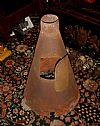
Click to Enlarge |
This is an original Civil War Period hand-forged Sibley Stove which was being used in Texas as a smudge pot to heat the trees in an orange grove! The hinged door works great. There is some rust at top where stack pipe would be added to carry fumes out the top of a peaked (Sibley) tent. There is also some flakey rusting and mild corroded spots along the base that was against the ground for all those years. But overall, this is a very solid (and heavy!)item, measuring about 29" high and 20" across at base.
Patented by Major Henry H. Sibley in 1857, getting a $5 Royalty from the War Department on each stove until he resigned in 1861 to join the Confederacy. These were also still heavily used in the West during the Indian Wars. This is shown in Francis Lord's Volume I Civil War Book.
Adams Express Envelope Money Going Home

Click to Enlarge |
Well, way before there was UPS, there was the popular "Adams Express Company" which during the Civil War period sent secure packages and envelopes directly between individuals. It was often used to ship important notices, letters, private documents, money and even goods between two locations. Even those places close to current armed conflicts! This is a five wax-stamp sealed envelope originally containing $50 (a LOT of money then!) sent home by a soldier to his family in Minnesota. Yes, in spite of war and deadly conflict, men still needed a reliable messenger service to send practical items and currency to-and-fro from their distant campsites to their families back home.
Waiting at home for Daddy...
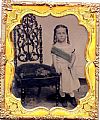
Click to Enlarge |
Not only did soldiers have their own images prepared and sent to wives, sweethearts and parents, but they carried-off pictures of their loved-ones to war with them. In fact, after the Battle of Gettysburg a photograph of children was found upon the unidentified body of a Union soldier. It was copied and published in various newspapers across the Union until the widow recognized her childrens' image and stepped forward to identify her sadly-lost husband. The woman was given the priviledge of running the orphan's home in Gettysburg for many years afterward. This particular image shows a little girl in a sash-adorned dress who misses her daddy...
Civil War Period Animal Bone Dice

Click to Enlarge |
Dice were a popular game od chance between bored soldiers in camp. Before the advent of plastics, dice werre made of animal bone or ivory.
Lead poker chips...

Click to Enlarge |
Poker and gambling at cards was very popular amongst troops on both sides of the poicket line. Chips for poker games were often field-crafted from lead bullets that were hammered into flat discs.
Wooden lice comb

Click to Enlarge |
While officers used ivory, bone and shell, the common man used lice comb of basic wood. Combing lice and their eggs (nits) out of one's hair and beard kept the itch off a soldier on the march or under his blankets...
Religious Icon

Click to Enlarge |
Many Civil War Soldiers were deeply religious in various faiths, but Christianity tended to predominate at that time. Troops carried Bibles, crucifixes, medallions and even small religious icons made of brass or painted-lead like this tiny cased statuette shown. Often, before going into deadly action, Priests and Ministers would bless a Regiment. Brothers would soon move onto other spiritual spheres...
Officer's Inkwell...

Click to Enlarge |
Ink tended to be sold for writing in small crockery bottles. But some men brought small lidded metal inkwells from home. They had a cork liner that prevented spillage when inside a lapdesk or even a knapsack. More likely the property of a young officer, but any man could have owned this desk accessory and used it to write home to mother just before facing the music of a hot cannon's roar.
Ivory Week Planner

Click to Enlarge |
Before there were Office Superstores selling ledgers and yearly planners... before wall calendars and computer memory... there was the human mind and then the legendary pencil! These small weekly planners were made of pivoting sheets of thin bone or ivory upon which the days of the week were imprinted. The soldier could then use a lead pencil to scribble a tiny note to himself for upcoming days of that week. The lead could be wiped away with some spit or finger weat in order to use it over the next week. Can't you almost see the possible notes on these for a soldier: Monday get bullets/ Tuesday march/ Wednesday fight at Gettysburg/ Thursday reload/ Friday visit wounded friends/ Saturday go to a town social in Carlisle/ Sunday rest...
Straight-edged Razor

Click to Enlarge |
In a war of bearded men, there was still a need to trim cheeks, necks and parts of the chin. With no double-edged or safety-razors as yet, the reliable straight-edged razor was carried and used by men on both sides of the battlefield.
1862 Fort Donelson Bible Flag

Click to Enlarge |
This is an incredible piece of history~ a true rarity! A hand sewn commenorative "Battle Flag" bible bookmark that lists the dates of the major rengagement between Union and Confederate forces at Fort Donelson. It was likely sewn in honor of a soldier's service there. The construction and aging demonstrate that this was crafted during the Civil War itself. Sadly, the original owner's name and regiment was never added to the ink notation on the back cloth panel. It's size is 4 1/2 Inches by 3 3/8 inches in order to fit inside a bible or book. It appears to be made of pieced-silk sections with 5" long tassels and a early ring of concentric stars flag design. How fortunate that this delicate work has survived all of these many decades!
Soldier's Needle & Repair Kit: called

Click to Enlarge |
This is a rolled kit of thread, needles and cloth patches that were carried by solders to mend their garments & socks. It was called a "housewife" in lieu of a real, caring woman to tend the wandering warrior... Being cloth and purely practical i9n nature, many of these did not survive the elements or later neglect of time. But they were a very practical matter of survival during war, like socks, stamps, ink, bread and a blanket in winter... It measures 3 3/4" x 7" and 3/4 thick, being made out of a black leatherette and cloth material. Still contains the original pins and needles. Both ends of the housewife are fashioned to be pincushions,where there are still pins present.When it is unrolled, the original needles are shown. A soldier would usually add thread and a thimble.This is very well preserved and quite a representative example.
Gold Medal of a Confederate Chief Surgeon

Click to Enlarge |
This stunning gold medal demonstrates a fantastic sunburst effect. It is inscribed to: Dr. Frank Rice, Chief Surgeon of Gen. Cheatham's Div., Army of Tenn., C.S.A. Likely it was given to him after the Civil War by appreciative comrads or family. On the reverse, it reads: Surrendered at Greensboro, N.C. April 26, 1865." This is an extremely rare item attributed to a high-ranking officer. Its overall length is 6 inches in diameter. Unclear if solid gold or not. Descended directly through descendants. Now in a fine private collection. It is one of a kind, extremely rare item of tremendous historical significance! It is so lucky that the trail of information and identification was kept with this item for future CW enthusiasts to see and understand fully.
Wooden Civil War Period Chess Set

Click to Enlarge |
Poker, dice and checkers were much more popular with the lower ranks, while some officers might also play the more "heady" games of backgammon and chess. This is the typical wooden chess set of the Civil War Period...
Refreshment Saloon & Depot for Troops on Leave

Click to Enlarge |
Large cities, such as New York, Chicago, Philadelphia and Washington had "refreshment saloons" or large depots where troops passing through town on leave could stop for food, lodging, companionship and minor ailments. For the more seriously sick or injured, there were large official military hospitals in bigger cities. The Philadelphia "Refreshment SAloon" was famous for its size and hospitality, quickly becoming popular with Union troopers. An association between the official armed forces and Christian charity groups made this service possible to tens of thousands of men in the course of the Civil War. Old lithographs often show these depots in their hey day. But engravings of military hospitals can be found as well. The soldiers liked to show where they'd been when tested to the limits of their endurance between 1861 and 1865.
Fancy Double Carved Bullet: Chess Rook!

Click to Enlarge |
Two bullets were artfully carved by a Civil War soldier into a fancy rook or castle piece for a chess set. Both pieces were dug up together!
Key to Survival

Click to Enlarge |
Not all things come through the fury of devastation of a war intact or unscathed... Considering the force of weapons and degree of raw emotions directing them, the fragile wrap of a man's body can be blasted, pierced or boroken so easily... and not always brough back through repair. Imagine the awesome energies that squashed this pinky ring so flat at Fredericksburg, Virginia in 1862... Who wore it till the bitter end during that mean December battle?
Clockworks rowel unique Union Spur

Click to Enlarge |
Union Army Reimbursement for a Black Servant

Click to Enlarge |
This is an official Civil War Union army form that was filled out by 2nd Lieutenant F.H. Peterson to obtain reimbursement for his black manservant George Bowman. On the bottom left it has a box that names that servant who happens to be five feet five inches tall. This is an interesting Civil War period document considering that the North was supposedly fighting to free slaves down South, and yet, some Northern officers took their own blacks along with them to war as their technically "paid servants". This word-play seems a bit ironic to me!
A Bullet for War turned into a Dice for Fun

Click to Enlarge |
This is a lead .69 Caliber bullet that was carved by a Civil War trooper into a gaming dice. It was recovered in 1985 from the Camp of the 55th New York Vols. along Warrenton Turnpkie, Centerville, Va.
Carved Chess Piece 4 South Carolina Infantry

Click to Enlarge |
This carved lead minie bullet was dug from "Kamp Washington" at Jermantown, Fairfax County, Virginia by famed old tyme digger Norm Latcher. It was the camp of the 4th South Carolina Confederate Infantry. Looks like a chess Rook to me. Men often made their own pieces out of bullets
Tin Candlestick GAR paint

Click to Enlarge |
This is a tin candlestick from 1800's. It was common household item which easily could have been purchased for camp life. One lifts the thumb tab which raises candle from inside shaft. It has gold paint on it, suggesting that it was donated to a GAR Hall display case after war. Slider still works!
ID Grouping Harvey Bryant

Click to Enlarge |
This is a group of items from Union Soldier Harvey Bryant. It includes locks of hair glued to a card from his family from 1860's to early 1900's. In fact, there is a 1917 postcard from a nephew to Uncle Grant Bryant when he was fifty! Also, were two envelopes from Department of Interior in 1904, one containing a Pension form for soldiers from 1901.
1863 Ordnance Book of 26 Maine Lieutenant
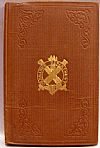
Click to Enlarge |
This is an 1863 military book: Ordnance and Ordnance Stores released by Ordnance Bureau Washington, Government Printing Office. It has nice gold embossed logo on cover. Full of facts and figures. Best of all, it is inscribed in pencil as the proptery of Lieut. T. Thorndike R.Q.M. 26 Me. Vols. From Belfast, ME. he survived the war. Some mild foxing to pages but overall sturdy and clean. 9" by 6".
Pocket Photo Album of John Johnson 49 NY Reg

Click to Enlarge |
This is a small pocket photo album of John T. Johnson of Nunda, New York who was in Co. B, 49th NY Reg. His name is inside covers in pencil 3 times. Written inside it says: "Washington/ This is my present posision". So Johnson likely had it with him while serving in War. It contained 5 tintypes and 3 CDV of civilian family members. It is 4 1/2" by 3 1/4". Many troops carried small albums, bibles and diaries that were this size.
Saucy Civil War Soldiers Ring
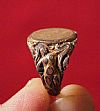
Click to Enlarge |
This gold plated ring was dug in one of Butler's Union Camps at Bemuda Hundred in Virginia. It shows saucy naked women on the sides. Guess the lads needed to be reminded of what waited back home if victorious!
Fancy Mother of Pearl UNION inlaid calling card case
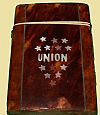
Click to Enlarge |
This is a very fine calling card case from Civil War era. It has a burl wood veneer over its body, into which is set finely carved mother-of-pearl stars forming the word "Union". It flips open to allow access to owner's calling cards.
Silver Three Cent Piece from Petersburg

Click to Enlarge |
This is a silver US Three Cent Piece, called a "trime", from Flank Road, Petersburg. It is worn by circulation use, but I think it is an 1853. This would buy a postage stamp to anywhere in Union during Civil War.
Ambrotype of CW child with her Nipper

Click to Enlarge |
This is a cute ambrotype photograph of a young child in her big Civil War era dress. Her dog Nipper stands next to her.
Soldier Carved Nude Female musket vent pick

Click to Enlarge |
This is quite unique. A soldier-carved tiny lead Nude Woman placed upon the vent-pick for a musket! Found in Cold Harbor battle area in 1967. An army of young males was quite likely to have natural interests in ladies. This soldier was away from loved ones in a dangerous environment.... and he carved something that interested him.
Brass ring with naked women found Cold Harbor

Click to Enlarge |
This is a dug brass pinky ring which was recovered at Cold Harbor with the land owner's permission. On each side, it shows a naked woman. Very risqué for the CW era! The back is broken but design and main face are great. Very cool example of a young soldier's real interests!
Death of Ellsworths Killer Patriotic Envelope

Click to Enlarge |
This is a Union patriotic Envelope showing the famous death scene of Colonel Ellsworth. One of his troopers then killed his rebel murderer... Unused. Has an 1861 Copyright on back flap.
Grouping ID to Capt A. Marple 104 PA Inf. Vols.

Click to Enlarge |
This is a grouping of items which belonged to Captain Alfred Marple of Co. F of the 104th Pennsylvania Volunteer Infantry. They were found on a relic board at a Bucks County, PA. estate. They include: a single Union Infantry Captain's Smith Patent shoulder board. On it's blue cloth field in old ink is written : Alfred Marple, Doylestown, PA. In addition, there are 3 veteran's GAR which came alongside it: A brass GAR wreath insignia for veteran's kepi; and two GAR medal bars: one for a Colonel and one for a First Lieutenant. Captain Marple enlisted on September 12, 1861 and was mustered out with the company on September 30, 1864. But most interestingly, Captain Marple was at Ford's Theater the night Lincoln was assassinated!
Silver Crucifix from New York Camp Stafford VA

Click to Enlarge |
This is a silver crucifix recovered in the camp of the 58 New York Volunteer Infantry Regiment stationed briefly in Stafford Virginia. It has Orthodox Christian motifs & styling. These troops were largely from Slavic neighborhoods, so the Orthodox type of styling makes sense. Has hallmarks for silversmith on the back. Only about 1 1/4" high. Most CW crucifix are brass or bronze. So recovering a true silver one is uncommon.
Custom animal Bone Camp Spinner Game Piece

Click to Enlarge |
This is a custom-carved animal bone spinner that was used as a game in camp by bored troops. Either for fun or wagers? It is spun to see which number it ultimately falls upon. Quite rare and excellent condition. Photo kindly donated to the Cyber Museum by The Barry Pipino Collection.
Jeweler Watchmaker Civil War Copper Token

Click to Enlarge |
There was a coin shortage during Civil War. So industrious people started minting their own copper coins privately. (This was finally forbidden by Federal Government in 1864) Many tokens advertised local businesses on one side and had some Patriotic Union motif on the other side. This one advertizes a Watchmaker Jeweler.
French made Compass in nice Wood Box
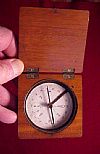
Click to Enlarge |
This is a CW era compass in a nice walnut wood box with a latch. It says "Made in France". Many telescopes and instruments were imported from Europe during the CW era. It works great. Box about 3 by 3 inches.
|

